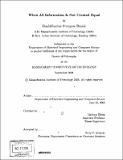When all information is not created equal
Author(s)
Borade, Shashibhushan Prataprao, 1981-
DownloadFull printable version (16.80Mb)
Other Contributors
Massachusetts Institute of Technology. Dept. of Electrical Engineering and Computer Science.
Advisor
Lizhong Zheng.
Terms of use
Metadata
Show full item recordAbstract
Following Shannon's landmark paper, the classical theoretical framework for communication is based on a simplifying assumption that all information is equally important, thus aiming to provide a uniform protection to all information. However, this homogeneous view of information is not suitable for a variety of modern-day communication scenarios such as wireless and sensor networks, video transmission, interactive systems, and control applications. For example, an emergency alarm from a sensor network needs more protection than other transmitted information. Similarly, the coarse resolution of an image needs better protection than its finer details. For such heterogeneous information, if providing a uniformly high protection level to all parts of the information is infeasible, it is desirable to provide different protection levels based on the importance of those parts. The main objective of this thesis is to extend classical information theory to address this heterogeneous nature of information. Many theoretical tools needed for this are fundamentally different from the conventional homogeneous setting. One key issue is that bits are no more a sufficient measure of information. We develop a general framework for understanding the fundamental limits of transmitting such information, calculate such fundamental limits, and provide optimal architectures for achieving these limits. Our analysis shows that even without sacrificing the data-rate from channel capacity, some crucial parts of information can be protected with exponential reliability. This research would challenge the notion that a set of homogenous bits should necessarily be viewed as a universal interface to the physical layer; this potentially impacts the design of network architectures. This thesis also develops two novel approaches for simplifying such difficult problems in information theory. Our formulations are based on ideas from graphical models and Euclidean geometry and provide canonical examples for network information theory. They provide fresh insights into previously intractable problems as well as generalize previous related results.
Description
Thesis (Ph. D.)--Massachusetts Institute of Technology, Dept. of Electrical Engineering and Computer Science, 2008. Includes bibliographical references (p. 191-196).
Date issued
2008Department
Massachusetts Institute of Technology. Department of Electrical Engineering and Computer SciencePublisher
Massachusetts Institute of Technology
Keywords
Electrical Engineering and Computer Science.